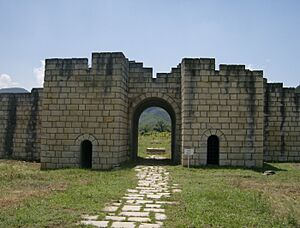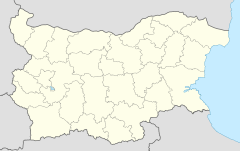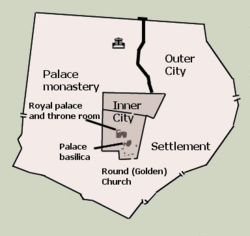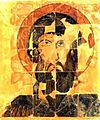Veliki Preslav facts for kids
Quick facts for kids
Veliki Preslav
Велики Преслав
|
|
|---|---|
 |
|
| Country | |
| Province (Oblast) |
Shumen |
| Elevation | 92 m (302 ft) |
| Population
(2009-12-31)
|
|
| • City | 8,951 |
| • Urban | 14,960 |
| Time zone | UTC+2 (EET) |
| • Summer (DST) | UTC+3 (EEST) |
| Postal Code |
9850
|
| Area code(s) | 0538 |
Veliki Preslav, also known as Great Preslav, is a city in Bulgaria. Its name in Bulgarian is Bulgarian: Велики Преслав. Before 1993, it was simply called Preslav. This city is the main town of the Veliki Preslav Municipality, which is part of Shumen Province. Veliki Preslav is located about 92 meters (300 feet) above sea level.
This city was once a small village. It got its current name in 1878 and officially became a town in 1883. As of December 2009, about 8,951 people lived there.
Preslav was super important in the past! It was the capital city of the First Bulgarian Empire from 893 to 972. This made it one of the most significant cities in Southeastern Europe during the Middle Ages. Today, you can visit the ruins of the old city. They are located in northeastern Bulgaria, about 20 kilometers southwest of Shumen. These ruins are now a national archaeological reserve, which means they are protected and studied by experts.
Contents
History of Veliki Preslav
The name Preslav comes from a Slavic word. It seems like the city started as a Slavic village. It was then made stronger with walls and defenses in the early 800s. Preslav grew quickly because it was close to Pliska, which was the Bulgarian capital at the time. This growth happened during the rule of leaders like Khans Krum and Omurtag.
By 852, when Khan Boris I became ruler, Preslav was already a key military spot. Many churches were built in the city after the Bulgarians became Christian in 864.
Preslav Becomes the Capital
A big event in 892 changed Preslav's future. Some nobles in Pliska, led by Prince Vladimir, tried to bring back old pagan beliefs. But Vladimir was removed from power. In 893, during a special meeting called the Council of Preslav, Boris I chose Simeon the Great to be the new ruler. He also decided to move the capital from Pliska to Preslav. Pliska was still seen as a bit pagan, so moving the capital to Preslav was a fresh start.
For the next 80 years, Preslav grew very fast. It became the center for Bulgarian politics and important meetings. It also became a hub for Slavic culture, writing, and art. One old writer said it took Simeon 28 years to build his new capital. But discoveries show the city kept growing even after that, reaching its best time in the mid-900s under Emperor Peter I of Bulgaria.
A City of Culture and Art
Preslav was a truly amazing city. It had impressive city planning, a strong economy, and grand buildings like the Round Church and the Royal Palace. It was so grand that it could compare to other major cities in Western Europe.
Culturally, Preslav was home to the Preslav Literary School. This school started in Pliska in 886 and moved to Preslav in 893. Many great Bulgarian writers from the Old Bulgarian period worked here. These included John Exarch, Constantine of Preslav, and Chernorizets Hrabar. It was probably at this school that the Cyrillic script was developed in the 900s. This is the alphabet used for Bulgarian and many other languages today! The city also had large workshops that made beautiful ceramic art, shiny glazed tiles, and even ceramic icons.
The Decline of Preslav
Things started to go downhill for Preslav in the late 960s. The city was taken over by Kievan Prince Sviatoslav. A war then broke out between Sviatoslav's army and the Byzantines. The Byzantine Emperor John I Tzimisces attacked and burned the city. The invaders took away the treasury, the Bulgarian Tsar's special royal items, and many books from Simeon's library.
Even though the city remained somewhat important for the next 300 years, its surrounding areas and big monasteries became empty. The economy also lost its strength.
Preslav became a bit important again when the Second Bulgarian Empire was founded. One of the founders, Peter IV of Bulgaria, lived in Preslav. This showed that Bulgaria was a strong country again. However, another city, Tarnovgrad, became more important over time.
By the 1200s, Preslav's importance faded. Attacks by the Tatars in the 1270s made the last people leave Preslav. Some of these people built a new village with the same name. This new village is where the modern town of Veliki Preslav is located today.
Did you know? Preslav Crag on Livingston Island in Antarctica is named after Preslav!
Education
- Simeon Veliki's technical high school
- Farming high school
Culture
The National Historical and Archaeological Reserve and Museum are located in Veliki Preslav. In 1906, Yordan Gospodinov and K. Shkorpil started the Archaeological Society "Ticha" here. Every year, the town holds May cultural celebrations called "Spring in Preslav." The Community Center "Razvitie" was started in 1874.
Sport
- FC Preslav
Images for kids
-
The Byzantines attack Preslav, in a drawing from the 11th century chronicle of John Skylitzes
See also
- Preslav treasure
























